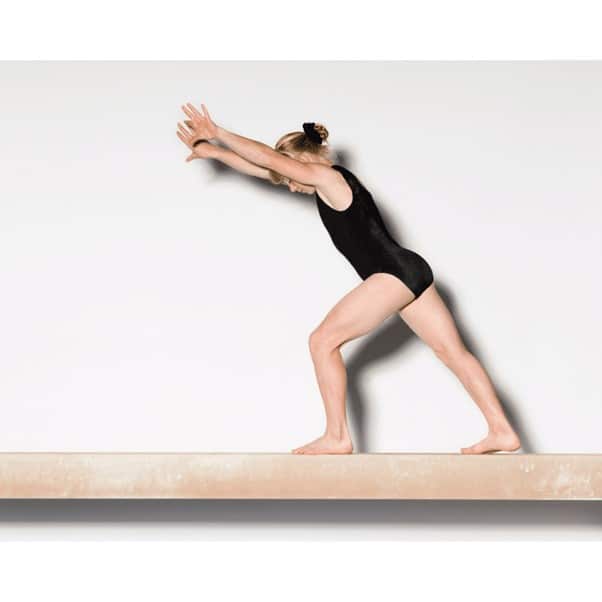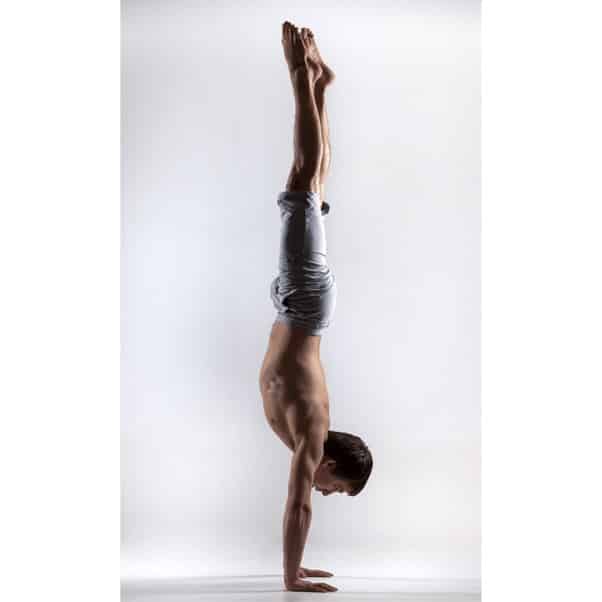Mastering how to do a front handspring is an important milestone for a gymnast. It will unlock key skills needed for more advanced Tumbling and Vault Skills and help gymnasts become more successful. A front handspring is a fundamental gymnastics skill that involves explosive power and coordination and requires lots of progressions and preparation.

This article will explain what a front handspring is, how to do it, progressions, common faults and benefits.
Disclaimer: The information in this article is intended to be generic and does not replace the need for professional guidance in a recognized gymnastics facility. Gymnastics carries an inherent level of risk and Complete Gymnastics will not be held responsible for any injuries arising from practice.
What is a Front Handspring?
A front handspring is a tumbling skill where the gymnast moves forward, pushes through a handstand shape and rotates over onto feet. It is considered a fundamental skill in artistic gymnastics. Front handsprings can be performed as a single skill or have other skills linked after it such as front somersaults.
When performed correctly, the body remains extended throughout the rotation and on landing a rebound (bounce) will be created. This rebound is what allows a gymnast to potentially add a somersault after the handspring.
The Front Handspring is also performed over the vault.
When being performed on Vault the gymnast jumps with both feet from the springboard which differentiates it from the floor version which is performed by hurdle stepping with one leg leading out in front and the feet only coming together when the gymnast is near the handstand position.
How to do a Front Handspring Step by Step
Mastering a front handspring requires proper technique and step-by-step progressions. Here are tips for how to perform the skill correctly:
1. Short run-up
Take a few steps to generate momentum and power into the front handspring. Running strides should be long allowing the body and hips to extend.
2. Hurdle step
The hurdle step is the last step of the run-up and transitions into the handspring. To perform a hurdle step hop on the rear leg, and lunge through the leading leg. Swing arms forcefully backward and push hips forward to begin driving into the floor.
3. Reach hands towards the floor
As you hurdle step, quickly reach both arms forwards and downwards. Reach hands aggressively towards the floor and look for the spot where they will contact.
Keep your arms straight and shoulders open as you contact the floor. Hands should land simultaneously
4. Swing the rear leg
As the hands reach towards the floor, the rear leg should swing up and over the head towards a handstand. The leg should stay extended and the foot pointed.
5. Push off from the shoulders
Immediately push forcefully off the floor, driving from your shoulder girdle. Use your shoulders to help generate momentum out of the handstand.
6. Open body towards the ceiling
Thrust your chest upwards as you leave the floor. The legs should come together as the body passes through handstand.
7. Land on feet
As the feet come toward the floor the chest should stay open in a tight arch shape and the head in a neutral position. Spot the ceiling for as long as possible.
The finish position will be slightly different depending on whether the handspring is going to have a move linked afterward or not. A traditional landing position with bent knees will be needed if nothing comes after the handspring.
To add another move the legs will stay straight so that a rebound and bounce is created from the floor.
Front Handspring Progressions
Front handsprings can be intimidating at first. Breaking the skill down into progressions builds confidence and proper technique. Here are some drills to start mastering the front handspring:
- Handstand against wall
- Handstand holds
- Handstand pops or jumps – push through shoulders to jump to inverted
- Handstand flatback – land on the back in a hollow dish shape
- Handstand forward rolls – roll out of a handstand
- Handstand to Bridge
These drills isolate the takeoff, inverted position and landing phases. Master each piece separately before combining them for the full handspring. Use mats, inclines and spotters as needed for support. Developing proper techniques ensures safety and success.

Common Handspring Errors
Mastering front handsprings takes time and practice. Patience is key. Here are some common faults and how to fix them:
Bent arms – Causes unsafe impact on the shoulders. Keep arms straight and locked throughout the rotation. Strengthen arms and shoulders.
Piked body – Losing tight body position prevents proper rotation. Focus on reaching tall through your toes and chest. Strengthen lower abs.
Uneven hand placement – Causes rotation to one side. Contact the floor directly under your shoulders in a straight handstand.
Lack of height – Doesn’t allow complete rotation room. Generate full explosive power from your legs and swing your arms aggressively.
Spotting issues – Leads to control problems upon landing. Pick a spot and lock eyes on it throughout the skill.
Bending forward on landing – Absorb landing forces through your entire foot, not just toes. Keep chest lifted.
Be patient through the learning process. Go back to drill progressions to ingrain proper technique. Front handsprings require power, coordination and practice.
Benefits of Learning Front Handsprings
While challenging, mastering the front handspring provides many benefits:
- Builds explosiveness and leg power
- Develops body control in inverted positions
- Enhances coordination and timing
- Sets foundation for more advanced skills
- Boosts confidence in other gymnastics events
- Improves overall body awareness
The handspring movement pattern transfers to vaulting as well. Gymnasts must learn to generate speed and power for big tricks. Front handsprings help develop these key qualities.
Patience, perseverance and proper progressions will pay off as gymnasts master this essential building block skill. The benefits carry through to reach higher levels of gymnastics achievement.
Conclusion
In summary, the front handspring is an important skill where gymnasts jump up and rotate hands-over-head in a tight straight body position. They drive the arms forward and explosively push off the shoulders to land upright. Proper technique, progressions and patience are key to mastering front handsprings. This skill builds power, body control and coordination for higher-level gymnastics.
While challenging, gymnasts who learn how to do a front handspring gain key abilities that set the foundation for future skill development and success in the sport.
FAQs
Is a Front Handspring easy to learn?
No, a front handspring is difficult and requires strength and time to practice the progressions repetitively. Most beginners will be unable to perform a front handspring straightaway.
Is a Front Handspring or Back Handspring easier?
This is down to personal preference however many people find back handspring difficult because they can’t see the floor behind them.
How long does it take to learn a front handspring?
There are many factors that affect the time needed to learn a front handspring. However, with regular practice and conditioning, you could expect to learn a front handspring within six months.
Do you have to be flexible to do a front handspring?
The main area of flexibility needed for a front handspring is in the shoulder angle under the armpit. You need this to fully open in order to perform a good front handspring. If you can hold a handstand with good form then this would indicate you have
- How to Do a Back Handspring: Complete Step-by-Step GuideLearning how to do a back handspring is an exciting milestone for any gymnast. It builds confidence, agility, and forms the foundation for advanced tumbling… Read more: How to Do a Back Handspring: Complete Step-by-Step Guide
- How To Get Over a Mental Block In Gymnastics: A Complete GuideGymnastics is a sport that requires not only physical strength and skill but also mental strength. When a gymnast feels like they cannot attempt a… Read more: How To Get Over a Mental Block In Gymnastics: A Complete Guide
- The Best Leotard for Girls in 2025: What to Look ForFinding an ideal leotard for girls isn’t just about picking a dazzling design that sparkles (although it does help!). The leotard has to fit perfectly,… Read more: The Best Leotard for Girls in 2025: What to Look For
- The Best Gymnastics Shorts (Our Top Picks)The best gymnastics shorts are designed to be worn over the top of a leotard providing additional coverage around the upper legs, whilst allowing gymnasts… Read more: The Best Gymnastics Shorts (Our Top Picks)
- Decathlon Leotards – Are They Any Good?If you’re in the market for a new leotard, you may be wondering if Decathlon leotards are any good considering the low cost of their… Read more: Decathlon Leotards – Are They Any Good?
- A Complete Guide to Gymnastics Hand RipsAre you tired of dealing with painful gymnastics rips on your hands from training? Look no further – this article offers a comprehensive approach to… Read more: A Complete Guide to Gymnastics Hand Rips






